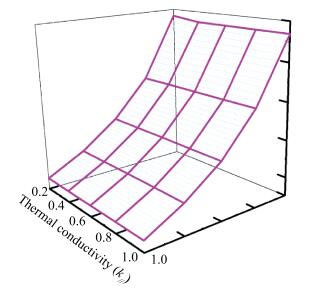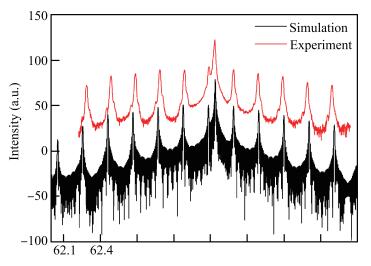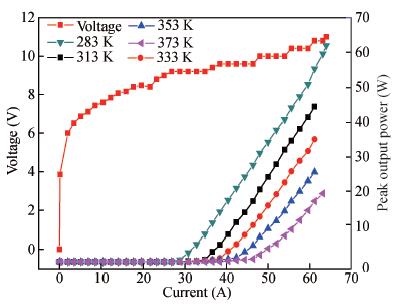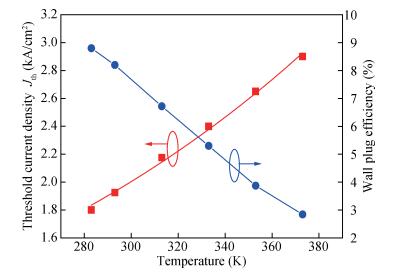| Citation: |
Yue Zhao, Fangliang Yan, Jinchuan Zhang, Fengqi Liu, Ning Zhuo, Junqi Liu, Lijun Wang, Zhanguo Wang. Broad area quantum cascade lasers operating in pulsed mode above 100 ℃ at λ~4.7μm[J]. Journal of Semiconductors, 2017, 38(7): 074005. doi: 10.1088/1674-4926/38/7/074005
****
Y Zhao, F L Yan, J C Zhang, F Q Liu, N Zhuo, J Q Liu, L J Wang, Z G Wang. Broad area quantum cascade lasers operating in pulsed mode above 100 ℃ at λ~4.7μm[J]. J. Semicond., 2017, 38(7): 074005. doi: 10.1088/1674-4926/38/7/074005.
|
Broad area quantum cascade lasers operating in pulsed mode above 100 ℃ at λ~4.7μm
DOI: 10.1088/1674-4926/38/7/074005
More Information
-
Abstract
We demonstrate a broad area (400 μm) high power quantum cascade laser (QCL). A total peak power of 62 W operating at room temperature is achieved at λ~4.7 μm. The temperature dependence of the peak power characteristic is given in the experiment, and also the temperature of the active zone is simulated by a finite-element-method (FEM). We find that the interface roughness of the active core has a great effect on the temperature of the active zone and can be enormously improved using the solid source molecular beam epitaxy (MBE) growth system.-
Keywords:
- high peak power,
- quantum cascade laser,
- interface roughness
-
References
[1] Faist J, Capasso F, Sivco D L, et al. Quantum cascade laser. Science, 1994, 264(5158): 553 doi: 10.1126/science.264.5158.553[2] Beck M, Hofstetter D, Aellen T, et al. Continuous wave operation of a mid-infrared semiconductor laser at room temperature. Science, 2002, 295(5553): 301 doi: 10.1126/science.1066408[3] Evans A, Yu J S, Slivken S, et al. Continuous-wave operation of λ ~ 4.8 μ m quantum-cascade lasers at room temperature. Appl Phys Lett, 2004, 85(12): 2166 doi: 10.1063/1.1793340[4] Zhang J C, Liu F Q, Tan S, et al. High-performance uncooled distributed-feedback quantum cascade laser without lateral regrowth. Appl Phys Lett, 2012, 100(11): 112105 doi: 10.1063/1.3693425[5] Bai Y, Slivken S, Darvish S R, et al. High power broad area quantum cascade lasers. Appl Phys Lett, 2009, 95(22): 221104 doi: 10.1063/1.3270043[6] Kosterev A, Wysocki G, Bakhirkin Y, et al. Application of quantum cascade lasers to trace gas analysis. Appl Phys B, 2008, 90(2):165 doi: 10.1007/s00340-007-2846-9[7] Nelson D D, Shorter J H, Mcmanus J B, et al. Sub-part-per-billion detection of nitric oxide in air using a thermoelectrically cooled mid-infrared quantum cascade laser spectrometer. Appl Phys B, 2002, 75(2): 343 https://www.researchgate.net/publication/225495477_Sub-part-per-billion_detection_of_nitric_oxide_in_air_using_a_thermoelectrically_cooled_mid-infrared_quantum_cascade_laser_spectrometer?ev=auth_pub[8] Yu J S, Evans A, Slivken S, et al. Temperature dependent characteristics of λ ~ 3.8 μm room-temperature continuous-wave quantum-cascade lasers. Appl Phys Lett, 2006, 88(25): 251118 doi: 10.1063/1.2216024[9] De Naurois G M, Simozrag B, Maisons G, et al. High thermal performance of μ -stripes quantum cascade laser. Appl Phys Lett, 2012, 101(4): 041113 doi: 10.1063/1.4739004[10] Lops A, Spagnolo V, Scamarcio G. Thermal modeling of GaIn-As/AlInAs, quantum cascade lasers. J Appl Phys, 2006, 100(4): 043109 doi: 10.1063/1.2222074[11] Martínmartín A, Iñiguez P, Jiménez J, et al. Role of the thermal boundary resistance of the quantum well interfaces on the degradation of high power laser diodes. J Appl Phys, 2011, 110(3): 033113 doi: 10.1063/1.3622508[12] Zhang Q, Liu F Q, Zhang W, et al. Thermal induced facet destructive feature of quantum cascade lasers. Appl Phys Lett, 2010, 96(14): 141117 doi: 10.1063/1.3385159[13] Faist J, Capasso F, Sirtori C, et al. Continuous-wave operation of a vertical transition quantum cascade laser above T= 80 K. Appl Phys Lett, 1995, 67(21): 3057 doi: 10.1063/1.114863[14] Liu F Q, Ding D, Bo X, et al. Strain-compensated quantum cascade lasers operating at room temperature. J Cryst Growth, 2000, 250(s3-4): 439 https://www.researchgate.net/publication/256745349_Realization_of_quantum_cascade_laser_operating_at_room_temperature[15] Duquesne J Y. Thermal conductivity of semiconductor superlattices: experimental study of interface scattering. Phys Rev B, 2009, 79(15): 897 https://www.researchgate.net/publication/45876853_Thermal_conductivity_of_semiconductor_superlattices_Experimental_study_of_interface_scattering[16] Capinski W S, Maris H J, Ruf T, et al. Thermal-conductivity measurements of GaAs/AlAs superlattices using a picosecond optical pump-and-probe technique. Phys Rev B, 1999, 59(12): 8105 doi: 10.1103/PhysRevB.59.8105[17] Yang B, Chen G. Partially coherent phonon heat conduction in superlattices. Phys Rev B, 2003, 67(19): 195331 doi: 10.1103/PhysRevB.67.195331[18] Spagnolo V, Lops A, Scamarcio G, et al. Improved thermal management of mid-IR quantum cascade laser. J Appl Phys, 2008, 103(4): 043103 doi: 10.1063/1.2840136[19] Termentzidis K, Chantrenne P, Keblinski P. Nonequilibrium molecular dynamics simulation of the in-plane thermal conductivity of superlattices with rough interfaces. Phys Rev, 2009, 79(21): 214307 doi: 10.1103/PhysRevB.79.214307[20] Daly B C, Maris H J, Imamura K, et al. Molecular dynamics calculation of the thermal conductivity of superlattices. Phys Rev B, 2002, 66(2): 626 http://www.researchgate.net/profile/Brian_Daly/publication/243435232_Molecular_dynamics_calculation_of_the_thermal_conductivity_of_superlattices/links/0deec53187aaa026e5000000.pdf?disableCoverPage=true[21] Hofstetter D, Beck M, Aellen T, et al. High-temperature operation of distributed feedback quantum-cascade lasers at 5.3 μ m. Appl Phys Lett, 2001, 78(4): 396 doi: 10.1063/1.1340865[22] Zhang J, Liu F, Wang L, et al. High performance surface grating distributed feedback quantum cascade laser. IEEE Photonics Technol Lett, 2013, 25(7): 686 doi: 10.1109/LPT.2013.2248081[23] Liu F Q, Li L, Wang L, et al. Solid source MBE growth of quantum cascade lasers. Appl Phys A, 2009, 97(3): 527 doi: 10.1007/s00339-009-5423-8[24] Bandyopadhyay N, Bai Y, Gokden B, et al. Watt level performance of quantum cascade lasers in room temperature continuous wave operation at λ ~ 3.76 μ m. Appl Phys Lett, 2010, 97(13): 1117[25] Bandyopadhyay N, Slivken S, Bai Y, et al. High power, continuous wave, room temperature operation of λ ~ 3.4 μ m and λ ~ 3.55 μ m InP-based quantum cascade lasers. Appl Phys Lett, 2012, 100(21): 212104 doi: 10.1063/1.4719110[26] Bandyopadhyay N, Bai Y, Tsao S, et al. Room temperature continuous wave operation of λ ~ 3-3.2 μ m quantum cascade lasers. Appl Phys Lett, 2012, 101(24): 241110 doi: 10.1063/1.4769038 -
Proportional views






 DownLoad:
DownLoad:

















